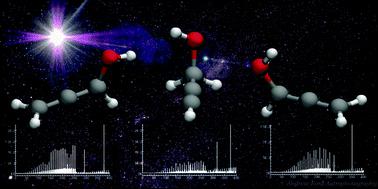当前位置:
X-MOL 学术
›
Phys. Chem. Chem. Phys.
›
论文详情
Our official English website, www.x-mol.net, welcomes your
feedback! (Note: you will need to create a separate account there.)
Interstellar hide and go seek: C3H4O. There and back (again)
Physical Chemistry Chemical Physics ( IF 2.9 ) Pub Date : 2022-06-22 , DOI: 10.1039/d2cp00995a Terri E Field-Theodore 1 , Peter R Taylor 1
Physical Chemistry Chemical Physics ( IF 2.9 ) Pub Date : 2022-06-22 , DOI: 10.1039/d2cp00995a Terri E Field-Theodore 1 , Peter R Taylor 1
Affiliation

|
The molecular species C3H4O represents a striking example of an astrochemical conundrum. With more than 60 structural isomers theoretically possible, to date only acrolein (CH2CHCHO) has been identified in the Sgr B2(N) region of the interstellar medium (ISM). The topography of the singlet potential energy surface is complicated, with three low-lying minima predicted to be almost isoenergetic: cis and trans-acrolein, and methylketene (CH3CHCO). Our CCSD(T)/cc-pVTZ calculations confirm that methylketene is energetically lower than cis-acrolein, lying only 1.9 kJ mol−1 above the trans-isomer, which is the global minimum. In this respect, methylketene is a promising candidate for interstellar observation. Unfortunately, however, despite several searches its astronomical detection has been unsuccessful. To this end, the key question is whether in fact methylketene exists as a discrete chemical entity in the ISM at all? In this paper, we present a detailed examination of the C3H4O potential energy surface, with specific focus on formation pathways. CCSD(T)/cc-pVTZ calculations enable a more elaborate interpretation of reaction mechanisms than was published hitherto. Our results show that gauche-propargyl alcohol and syn and anti-allenol emerge as interesting new targets for observational astronomers in TMC-1: given the recent discovery of the propargyl radical in this region, barrierless product channels involving OH˙ lend support to their candidacy as possible interstellar species. Finally, this work provides accurate spectral data of these three potential molecules, to be used for searches in interstellar space.
中文翻译:

星际捉迷藏:C3H4O。来回(再次)
分子种类 C 3 H 4 O 代表了天体化学难题的一个突出例子。理论上可能存在 60 多种结构异构体,迄今为止,在星际介质 (ISM) 的 Sgr B2(N) 区域中仅鉴定出丙烯醛 (CH 2 CHCHO)。单线态势能表面的形貌很复杂,预计三个低位最小值几乎是等能的:顺式和反式-丙烯醛,以及甲基乙烯酮 (CH 3 CHCO)。我们的 CCSD(T)/cc-pVTZ 计算证实甲基烯酮在能量上低于顺式-丙烯醛,仅比反式高 1.9 kJ mol -1-isomer,这是全局最小值。在这方面,甲基乙烯酮是星际观测的有希望的候选者。然而不幸的是,尽管进行了多次搜索,但它的天文探测一直没有成功。为此,关键问题是甲基乙烯酮实际上是否作为独立的化学实体存在于 ISM 中?在本文中,我们对 C 3 H 4 O 势能面进行了详细检查,特别关注形成途径。CCSD(T)/cc-pVTZ 计算能够比迄今为止发表的更详细地解释反应机制。我们的研究结果表明,gauche -propargyl alcohol 和syn和anti-丙二烯醇成为 TMC-1 观测天文学家感兴趣的新目标:鉴于最近在该区域发现了炔丙基自由基,涉及 OH˙ 的无障碍产物通道为他们作为可能的星际物种的候选资格提供了支持。最后,这项工作提供了这三种潜在分子的准确光谱数据,可用于星际空间的搜索。
更新日期:2022-06-22
中文翻译:

星际捉迷藏:C3H4O。来回(再次)
分子种类 C 3 H 4 O 代表了天体化学难题的一个突出例子。理论上可能存在 60 多种结构异构体,迄今为止,在星际介质 (ISM) 的 Sgr B2(N) 区域中仅鉴定出丙烯醛 (CH 2 CHCHO)。单线态势能表面的形貌很复杂,预计三个低位最小值几乎是等能的:顺式和反式-丙烯醛,以及甲基乙烯酮 (CH 3 CHCO)。我们的 CCSD(T)/cc-pVTZ 计算证实甲基烯酮在能量上低于顺式-丙烯醛,仅比反式高 1.9 kJ mol -1-isomer,这是全局最小值。在这方面,甲基乙烯酮是星际观测的有希望的候选者。然而不幸的是,尽管进行了多次搜索,但它的天文探测一直没有成功。为此,关键问题是甲基乙烯酮实际上是否作为独立的化学实体存在于 ISM 中?在本文中,我们对 C 3 H 4 O 势能面进行了详细检查,特别关注形成途径。CCSD(T)/cc-pVTZ 计算能够比迄今为止发表的更详细地解释反应机制。我们的研究结果表明,gauche -propargyl alcohol 和syn和anti-丙二烯醇成为 TMC-1 观测天文学家感兴趣的新目标:鉴于最近在该区域发现了炔丙基自由基,涉及 OH˙ 的无障碍产物通道为他们作为可能的星际物种的候选资格提供了支持。最后,这项工作提供了这三种潜在分子的准确光谱数据,可用于星际空间的搜索。











































 京公网安备 11010802027423号
京公网安备 11010802027423号